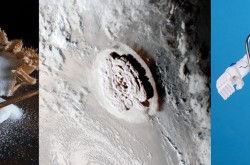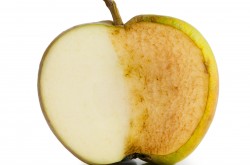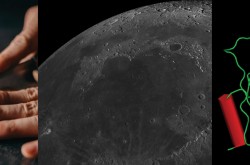3 things you should know about how mathematics is used for space exploration, how honeybees are masters of geometry, and the uniqueness of a shuffled deck of cards.

Meet Cassandra Marion, Renée-Claude Goulet, and Michelle Campbell Mekarski.
They are Ingenium’s science advisors, providing expert scientific advice on key subjects relating to the Canada Aviation and Space Museum, the Canada Agriculture and Food Museum, and the Canada Science and Technology Museum.
In this colourful monthly blog series, Ingenium’s science advisors offer up quirky nuggets related to their areas of expertise. For the September edition, they explain how mathematics is an indispensable tool for space exploration, how honeybees are masters of geometry, and about the unbelievable uniqueness of a shuffled deck of cards.

Consider the exacting calculations required to launch the Lunar Module ascent stage from the Moon’s surface and rendezvous with the orbiting Apollo 11 command module from which this photo was taken, some 384,000 kms from Earth.
Math: an indispensable tool for space exploration
Mathematics are essential for the observation, exploration and understanding of space. From basic arithmetic, calculus, algebra, geometry, and statistics and probabilities. It is interwoven into the fields of aerospace engineering, astronomy and planetary science. Without it, we would not have achieved spaceflight, we wouldn’t have satellite radio or GPS, we wouldn’t have landed on the Moon or flown a helicopter on Mars, or have ever seen high resolution images of Pluto. Here we review just a few of the countless ways we use math for space exploration.
To put a spacecraft in space, you first need a basic understanding of how our solar system operates. I’m referring to equations that describe gravity, Newton’s laws of motion, Kepler’s laws of planetary motion (how planets move in elliptical orbits around the Sun), and so on, that explain the forces acting on and motions of celestial bodies. These concepts are collectively known as “orbital mechanics,” which we have discovered or learned, through hundreds of years of observation, theory and manipulated equations.
Planning a mission to space requires math from simple unit conversions to budget management, to calculating astronomical distances, to modelling a spacecraft’s trajectory. To get to orbit, a rocket must launch off the surface of a rotating planet, which itself is also moving through space along its orbit around the Sun, all at different velocities. To get to the Moon, we add more variables and must predict the position of the Moon relative to the Earth when the spacecraft will arrive.
To launch a rocket requires several types of calculations starting with how much thrust – the force working opposite gravity and drag in this case – you’ll need to lift the weight of the rocket’s payload from the Earth’s surface, through its atmosphere and accelerate it to orbital velocity (7.8 km/s). A commonly used rocket equation enables us to do that by calculating the delta-v (Δv), the difference in velocity that is proportional to the thrust per unit mass and the burn time of the rocket’s engines. We must also determine the specific amount of propellant needed to fire the engines for the proper duration. Furthermore, these values are needed for each rocket stage as most modern rockets consist of several rockets stacked one atop another which progressively separate at pre-determined altitudes to reduce the total mass of the spacecraft. Once in orbit, computer modeling is needed to track the spacecraft’s position and speed, and navigate through space.
Instruments onboard spacecraft and telescopes on the Earth’s surface are used for a range of communications, navigation and remote sensing (e.g., cameras, spectrometers), and require math to create, operate and/or interpret returned data. With these, we have determined and measured characteristics and features of planetary bodies millions of kilometres away.
Math is an exceptional and indispensable tool for understanding and exploring our solar system and beyond.
Go Further
Space Math problems for classrooms @ NASA
By Cassandra Marion

Cells on a comb are exactly the right size to fit a honeybee. They serve as storage for pollen and honey, and as nursery for new bees.
Honeybees: masters of geometry
Honeybees are amazing engineers. Their innate ability to build complex wax honeycomb structures, with symmetrical, repeating hexagonal patterns has long puzzled bee observers and mathematicians alike. Why the hexagon, over any other shape? And how do bees know what to build? It appears nature figured out long before we did that the hexagon is simply the most efficient shape to build with.
From twelve to twenty days old, bees have a special gland in their stomach allowing them to convert the sugars they eat into wax. The wax comes out of their abdomen in flakes, which they then chew and apply to the structure in construction. Producing wax takes a lot of energy; a bee needs to eat 8 grams of honey for each gram of wax she makes. So every flake is precious, representing the work of the entire hive, and must be used most efficiently.
Honeybees use honeycombs as storage and nursery, so it’s logical they would also want to store the most in the least amount of space. A circular cell would hold the most, but when placed in a grid, each cell needs its own wall, and there is dead space between the circles – not a great use of a precious material. Bees have three basic shape options for tiling a surface with 100 percent coverage and no overlap: equilateral triangles, squares, or hexagons. These shapes are special because each of their sides can be shared with a neighbour, creating what is called a tessellation.
So why the hexagon, and not the triangle or the square? Because it reduces the amount of material needed for construction, while maximizing the storage capacity! This explanation is known as the “Honeycomb Conjecture,” which is thought to have been proposed some 2000 years ago, and at many other points in history. The idea is that hexagons are the most efficient way to pack shapes on a surface, so that each cell of the same size contains the maximum surface area, with the least perimeter. It took until 1999 for this to be proven mathematically, by an American mathematician named Thomas C. Hales.
Another great reason for the hexagon? Research has shown that due to the repeating 120-degree angles in each corner of the cells, the forces in the structure are in balance. This makes the honeycomb structure very strong, stable, and resistant to crushing, allowing bees to build the cell walls thinner than a sheet of paper!
Thanks to mathematics, we know that bees build structures that maximize space and stability, while minimizing building material. This knowledge can come in handy as we innovate to find new solutions in building materials, architecture, materials, and even in electronics. Today, bees continue to be a popular subject of study, and they surely have many other lessons to teach us!
By Renée-Claude Goulet

Un paquet de cartes mélangé tenu en éventail dans une main.
The unbelievable uniqueness of a shuffled deck
Find a standard deck of cards, shuffle it, and look at the order.
You are almost certainly holding an arrangement of cards that has never existed in history. In fact, it’s almost certain that if humans continue to use playing cards for millions of years, no one will shuffle a deck of cards into that exact order ever again!
How is that possible? Just how many ways are there to arrange a deck of cards?
Let’s start small. Imagine we have a deck with only two cards. We shuffle it, and lay out the cards one at a time. We have two possible options for the first card. If we lay that card down, we are left with one card to place second. So, in a two card deck, there are two possible ways to shuffle the deck: card A followed by card B or, card B followed by card A.
What about a three card deck? We have three possible options for the first card. If we lay the first card down, that leaves two possible options for the second card. If we place the second card next to the first, we are left with one card, which goes last. If we write out all the possible combinations of cards, they are: ABC, ACB, BAC, BCA, CAB, or CBA. So, there are six possible ways to shuffle our deck of three cards (three times as many ways as in the two card deck).
In a four card deck, we would have four options for the first card, which leaves three options for the second card, two options for the third, and the last card by default is placed fourth. In a four card deck, there are 24 possible ways to shuffle the deck (four times as many as in the three card deck).
Noticing a pattern? We can calculate the number of possible combinations of any size deck of cards using a simple formula called a factorial. Start with the number of cards in your deck and multiply it by consecutively smaller whole numbers until you get to one.
In a 2 card deck: 2 x 1 = 2
In a 3 card deck: 3 x 2 x 1 = 6
In a 4 card deck: 4 x 3 x 2 x 1 = 24
In a 5 card deck: 5 x 4 x 3 x 2 x 1 = 120
And so on.
A deck of 10 cards has more than 3 million combinations.
A deck of 20 cards has about two and a half quintillion combination (that’s 18 zeros).
A standard 52 card deck has 80,658,175,170,943,878,571,660,636,856,403,766,975,289,505,440,883,277,824,000,000,000,000 combinations (that’s 68 digits long!). That is an incomprehensibly large number. It’s FAR larger than the age of the universe if we counted in milliseconds (the universe is 13.8 billion years old). It’s more combinations than there are atoms in our entire galaxy (which contains more than 100,000,000,000 stars).
Whenever you shuffle a deck of cards, you’re holding something that will (almost certainly) only exist this one time, ever. It’s not magic. It’s math.
By Michelle Campbell Mekarski
Enjoying the Ingenium Channel? Help us improve your experience with a short survey!








































